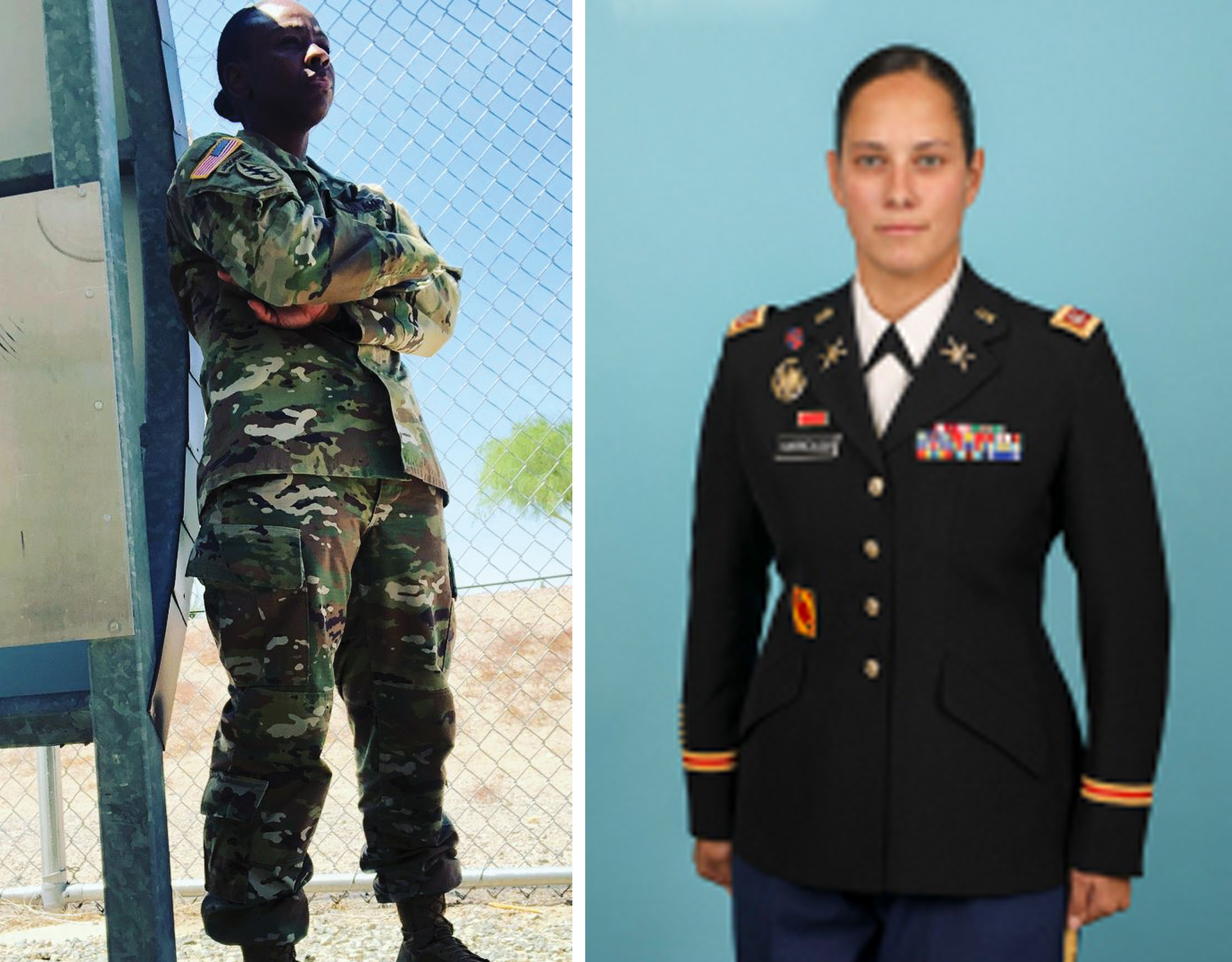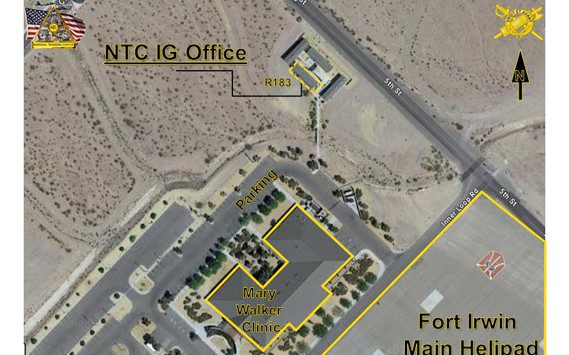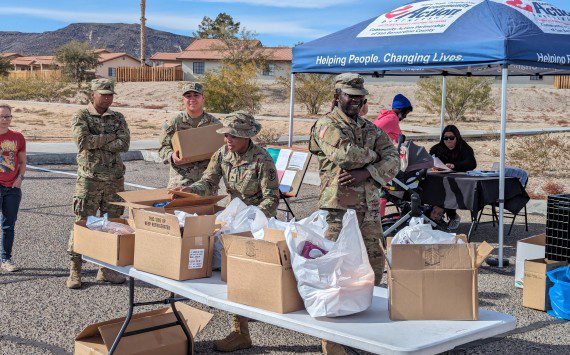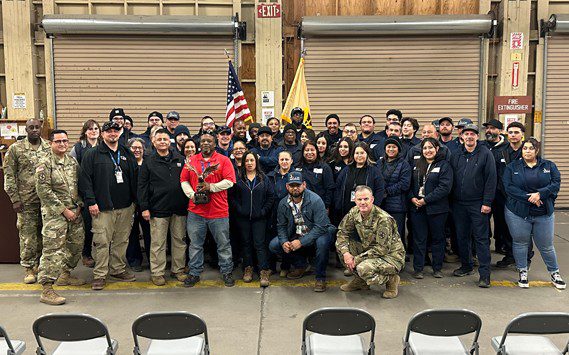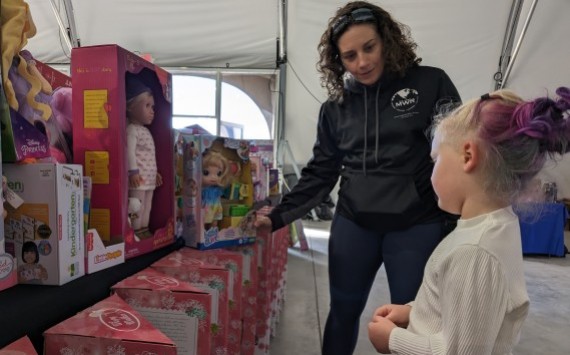FORT IRWIN, Calif — When Cpt. Jennifer Jackson decided to become an officer in the U.S. Army, her decision to enter into air defense artillery was not a tough one to make.
“The decision pretty much was not mine,” she said. “I completed an OCS (Officer Candidate School) packet and you had to pick one combat arms field and I actually picked artillery but was picked up for air defense artillery.”
She is one of only two women at the National Training Center and Fort Irwin who works in artillery.
Women make up less than one percent of those serving in infantry, armor and field artillery in the Army. Since 2016, more than 1,200 women have been serving in those combat arms areas. There are more than 427,000 people in the Army.
Both Jackson and Cpt. Stephanie Torrealba serve as Air Defense Artillery Operations Officers within the Operations Group at NTC/Fort Irwin.
Torrealba said she’s not shocked that more women aren’t serving in artillery.
“Shocked? No, because air defense was one of the only combat arms open to females and now in the past years, all combat arms have been opened up but even so, I think we’re starting to have the first, female commanders in those branches, so as time moves on, I think those numbers will increase, but not surprising,” she said.
Overcoming stereotypes
Both women have served in air defense artillery for about 10 years and said, as women, they definitely had to prove themselves when they first entered this area.
“When I first got to my unit as a second lieutenant, it was a very big change of dynamic, so a lot of the males were looking at females as being weak, and not being able to do our jobs,” Jackson said. “And in addition, transitioning into air defense, you have to learn a lot in a short amount of time and it’s a big deal, so showing up to PT every morning, having to run them into the ground and then going to work, showing them up and saying that I can do this and I’m here to fight.”
Jackson said it took about two years to prove herself in her new role, after learning the system and everyone’s positions, as well as going to back-to-back field trainings.
“So by the time we deployed that third year, it’s like ‘ok, she knows what she’s doing, we can trust her, we’re going to follow her into the fight,’” she said of her fellow soldiers.
Torrealba said her gender wasn’t the only reason she may have been treated differently when she first entered air defense artillery.
“It wasn’t until I made the rank of captain that the perception of my performance changed and a lot of that is also because of maturity,” she said. “I was coming out of college, 21 years old and going right into a leadership role. Many of my soldiers and NCOs were obviously older than me, so learning how to manage all of that leadership responsibility and being confident within yourself, that just because I’m a female or I’m a young officer, I still know what’s right, I know how to do my job and move forward like that.”
Both women agree they had an initial feeling of pressure in such a male-dominated area.
“I always felt that because there was only so few of us and myself being one of the only female officers in the battalion, eyes were always on me, people were always watching me and I always had to do better than the guys because there was so much scrutiny,” Torrealba said. “At times it was rough—I could put in the same amount of effort or do the same thing as one of my male counterparts but wouldn’t necessarily get the same amount of praise or the same evaluations, just based on being the only one.”
But she said as time passed, she doesn’t feel the load was as heavy for women today.
“There’s still a lot of pressure to perform as a female just because there’s only few of us but at the same time, you’re a soldier first—get the job done and leaders will reward you based on your performance, not your gender,” Torrealba said.
The importance of mentors
Jackson said it was a female office who helped her understand she, too, had a seat at the table.
“Col. Janell Eickhoff was the first female officer that I worked for,” Jackson said. “She definitely taught me one thing about presenting yourself as knowledgeable and the head of your section. We would go to meetings and I would sit in the back corner and she started sending me to meetings and she said ‘your place is at that table, so go to the table and sit there and breathe,’ and that’s one of things that to this day, I will find the seat closest to the front and speak my piece and go from there.”
Torrealba talked about a female, full bird colonel who mentored her.
“There weren’t a lot of female captains in my specific branch growing up but even to this day, there are only three, female 06s (colonels) in my branch that are around and still competing,” Torrealba said.
“I was surrounded by one of them. She reached out to me, she’s currently an 06 at Fort Sill, and mentored me and say ‘hey, I’m going to be open with you— here’s the perception, this is what I went through, I see you’re going through some of this, too, and you’re not the only one and look where I am now, a full bird colonel, things aren’t that bad.’”
Jackson said it’s good to have a mentor no matter what your age or gender is and regardless of your profession. She’s happy to see an increase in women in nontraditional military roles.
Acceptance of women in combat arms
“Definitely the changes that I’ve seen are a lot more females are going into being senior gunners, so previously just because of height requirements, it was a male dominant section, but now females are like, okay, I can pick up the weapon and I can fire it, too,” Jackson said.
Why artillery?
Both women had a special interest in a similar field before deciding to enter the military.
Jackson studied Criminal Justice Law Enforcement and Torrealba had a connection to the military through law enforcement.
“I’ve always been active and I’ve always wanted to be in the military or be a law enforcement officer, something like that,” Torrealba said. “I’ve had good, family friends and mentors— one that was in the Army and one that was a nurse in the Army. One was an undercover DEA agent and one (a woman) played college basketball and everything I wanted to do, she was. Then when it was time to graduate, I got an ROTC scholarship and I already had an academic scholarship to the same university. I chose to go Army and become an officer.”
Torrealba went on to Western Michigan University and Jackson studied a year at Kent State University before deciding to join the military. Although she works in artillery now, Jackson didn’t think she’d be near weapons.
“My recruiter did not tell me I had to fire a weapon, he just said, ‘hey, you’re going to be in Supply, you’re going to have your own office, it’s going to be great,’” Jackson said. “Then I get to Basic Training and I had to fire a weapon.”
Jackson has now been in the Army for nearly 20 years, in artillery for 10 years and completed 27 rotations at NTC. Torrealba has served for 10 years and worked in air defense artillery the entire time, completing 16 rotations in her year-and-a-half at NTC. Both women fulfill the same role at NTC.
“What I do now is division-level planning and operations, so when we’re not in rotation, we plan,” Torrealba said. “I’m the subject matter expert for air defense artillery and we do plans and scenario building for the upcoming rotations. And then while we’re in rotation, becoming the current division air defense officer where brigade reports to.”
Lt. Col. Jonathon Genge worked with Torrealba when she was on the Ops Group Lizard Team at NTC. He said she’s a highly-motivated professional officer.
“Serving on Cobra Team as a Squadron Protection/ADA Trainer, Stephanie was a versatile leader and a true team-player,” he said. “She was an extremely valuable OC-T providing additional support in many capacities of the team from rotational training unit operations coverage to personnel and sustainment areas.”
Training more female, military leaders
Both women have advice to stay one step ahead, as a leader—not just a woman.
“The biggest thing is read, read doctrine, know your MOS (military occupational specialty), as well as be confident within yourself,” Torrealba said. “Once you get that inner confidence, it’ll project and people will see you differently because of that confidence and at the end of the day, we’re a soldier that happens to be a female, not necessarily being a female soldier. So if you go about your day as if you’re a female who should be treated differently, you’re setting yourself up for failure. At the end of the day, we’re soldiers first and females second.”
Jackson said women shouldn’t be afraid to speak up.
“Honestly, I would say lean on your NCOs (non-commissioned officers) of all ranks because they all have different experiences and different knowledge and don’t be afraid to ask questions, Jackson said. “I know there’s a lot of women who wouldn’t go into a position because they don’t want to ask questions and feel like they’re not knowledgeable or inexperienced. Ask all the questions you can, shadow as many people as you can and lean on your NCOs.”
In 2016, the first women graduated from Army’s infantry, armor and artillery basic officer leader courses.
The future of women in combat arms
Jackson said there’s nothing holding women back now.
“As far as going into artillery and ranger, do it, there is nothing out there but you and your standards, so don’t worry about what people are saying, don’t worry about what’s going on,” Jackson said. “You have milestones that you need to meet to be a ranger, be a ranger. And when I went to airborne school, there were no females in our unit that were airborne yet. So I went to airborne school and running, I love it, but all that running is different but I did it and I met the standard, so I think, stop listening to what everybody is saying and just do what you want to do.”
Torrealba doesn’t like to get caught up in being the first or only but said she realizes the importance.
“At the end of the day, it’s my job,” she said. “Everyone wants to be good at their job, so if you happen to be one of the only or the first, then great, it’s an absolute honor and good opportunity because then you become a face that others can look up to and you can start mentoring those younger leaders. But it’s not something I go around counting, like ‘how many officers or how many females are there in combat arms on this post?’ At the end of the day, you’re a soldier. Do your job and keep looking out for those behind you, so they can come up—they’re going to be the ones that replace you, so train them, mentor them, so they can take your job in a couple of years.”
Jackson talked about how the Army tests your skill levels and physicality, no matter what your gender.
“With the new PT test that’s coming up for our branch, the standard is set, she said. “I went out there and I performed, I passed, but there are a lot of men and women who can’t perform regardless, so I would just say focus on the standards and the goals and the mission and continue to fight.”
She went on to say, “There are a lot of people who feel that females being equal to men is a bad thing or a good thing—it’s just a thing and it’s a change and it’s going to happen.”
Torrealba said when she entered the Army as a platoon leader in 2011, she only remembers three women in a company battery of about 75 soldiers.
“Fast forwarding to now, in my battery of about 115, we had about 30 females, so the amount of females in air defense artillery in this MOS has jumped significantly,” she said. “Because we’re combat arms, you don’t really get the perception of females being weak. More so now, regardless of your gender, you’re a soldier first. You do your job and do it well and everything will be alright.”






